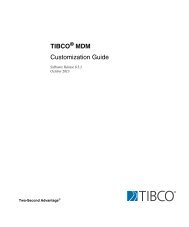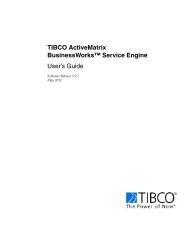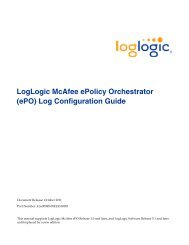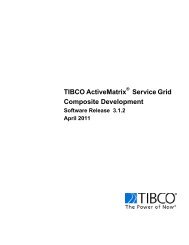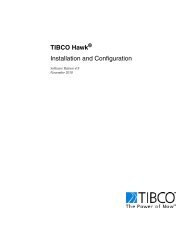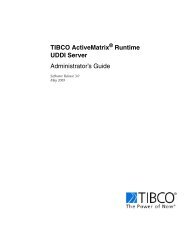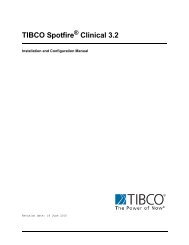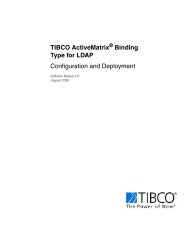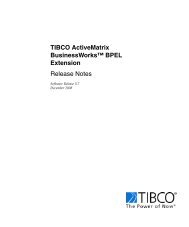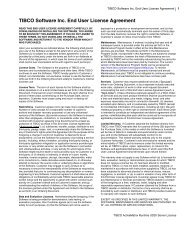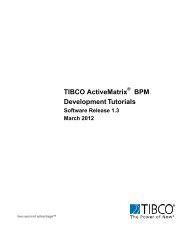TIBCO Spotfire Server 3.2.2 - TIBCO Product Documentation
TIBCO Spotfire Server 3.2.2 - TIBCO Product Documentation
TIBCO Spotfire Server 3.2.2 - TIBCO Product Documentation
You also want an ePaper? Increase the reach of your titles
YUMPU automatically turns print PDFs into web optimized ePapers that Google loves.
Authentication and User Directory<br />
8 Authentication and User Directory<br />
This chapter will outline and explain the different authentication and user directory<br />
mechanisms available in <strong>Spotfire</strong>. It will also try to guide and advise the <strong>Spotfire</strong><br />
administrator on which combination of authentication and user directory should be<br />
used in different situations. For exact instructions on how to configure the different<br />
methods, see the configuration console and its help.<br />
8.1 Overview<br />
Authentication is the function when users prove to the system who they are. The user<br />
directory is where the <strong>Spotfire</strong> system stores user and group names used to set and<br />
verify permissions. The <strong>Spotfire</strong> system is able to authenticate users internally or with<br />
external sources. User directory information may be synchronized with an external<br />
source. These settings are called authentication methods and user directory methods,<br />
respectively. Which methods and combinations to select depends entirely on factors<br />
such as number of users and what kind of infrastructure already exists in the network<br />
in which <strong>Spotfire</strong> is used.<br />
This chapter will provide an overview of the different combinations, instructions on<br />
how to set them up, and advice on which combination to choose, together with<br />
advantages and disadvantages of the different combinations.<br />
8.2 Username and Password Authentication<br />
When users start a <strong>Spotfire</strong> client, they are normally presented with a login dialog,<br />
where they supply their username and password. Using single sign-on methods,<br />
however, this window is bypassed and other forms of authentication are used, such as<br />
certificates or keys.<br />
The username and password authentication methods supported by <strong>Spotfire</strong> are:<br />
• LDAP Directory<br />
• <strong>Spotfire</strong> Database<br />
• Windows NT Domain<br />
• Custom JAAS Module<br />
All of these methods can be configured in the configuration console.<br />
For all methods, usernames are always stored in the <strong>Spotfire</strong> Database. When using an<br />
external authentication method, passwords and/or other authentication information is<br />
stored elsewhere, such as on an LDAP server or a Windows NT Domain Controller.<br />
<strong>TIBCO</strong> <strong>Spotfire</strong>® <strong>Server</strong> <strong>3.2.2</strong> 65 (144)



